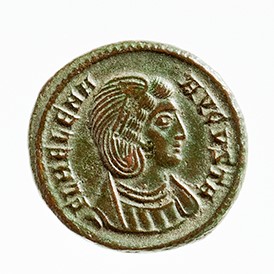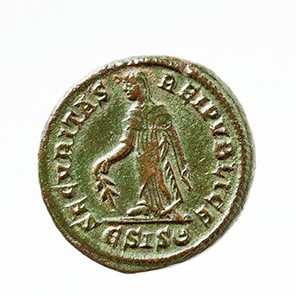Title: Follis of Helena, reign of Constantine - 1968.20
Acquisition number: 1968.20
Author or editor: Beryl Rawson
Culture or period: Roman Imperial
Date: AD 324-329
Material: Metal - Bronze
Object type: Coins - Roman
Dimensions: 17mm (w)
Origin region or location: Hungary
Origin city: Siscia
Display case or on loan: 7
Keywords: Coin, follis, Roman, Imperial, Helena, Constantine, Securitas, Pannonia, Siscia
See Sear, D.R., Roman Coins and their Values 5 vols (London, Spink, 2000-2014) 16608; Mattingly, H., E.A. Sydenham, C.H. Sutherland, R.A. Carson, The Roman Imperial Coinage 13 vols (London, Spink, 1923-1994) VII p. 453, 218.
Balsdon, J.P., Roman Women (London, Bodley Head, 1962) 165/170 and pl. 8(e); Reece, R., Roman Coins (London, Ernest Benn, 1970) 27/9, chs. XXIV and XXV, and pl. 54 no. 877 (cf. 878).
1968.20
Follis of Helena, reign of Constantine
3.293 g. AD 324-329
Obv.: Bust of Helena r., draped, diademed, hair looped over ears; wearing necklace and mantle. FL(auia) HELENA AVGVSTA.
Rev.: Securitas standing l., draped, with branch in right hand. SECVRITAS REIPVBLICE (sic). In exergue, ЄSIS followed by pointed crescent.
The Roman coinage system was reorganised by the emperor Diocletian c. AD 294. The new bronze follis (probably silver-washed) was at first larger than the antoninianus, but soon dwindled in size. The mint-mark on the reverse identifies the city of issue as Siscia (in Pannonia, modern Hungary). The mint here was opened c. AD 259, when this area became the centre for the military effort to defend the northern-central frontier. The pointed crescent at the end of the mint-mark is one of a number of designs differentiating particular workshops within a mint.
Helena was the mother of the emperor Constantine. Of low social origin and probably a Dalmatian, she was the concubine of Constantine’s father (Constantius I) before he married Theodora. But after Constantine became emperor in AD 306 he gave his mother a prominent place in the imperial family, and after his victory in November 324, which made him sole emperor, he conferred on her the title ‘Augusta’. (His wife Fausta also received this title at this time, and his son Constantius became Caesar.) Constantine’s own coins from AD 324 show a new image of a self-conscious, divinely-inspired ruler. The titles of the imperial women contributed to the exalted aura of the family. Constantine named a new city Helenopolis (in Bithynia) after his mother, and set up a number of statues of her in Constantinople. Helena was a convert to Christianity. She may have made a pilgrimage to Palestine. The earliest date for her death is AD 329. It may have been as late as AD 336.
The form of the diadem on Helena’s head helps to date her coins. The reverse celebrates the ‘security of the state’. Cf. Giacosa 124 and pl. LX.
See Sear, D.R., Roman Coins and their Values 5 vols (London, Spink, 2000-2014) 16608; Mattingly, H., E.A. Sydenham, C.H. Sutherland, R.A. Carson, The Roman Imperial Coinage 13 vols (London, Spink, 1923-1994) VII p. 453, 218.
Balsdon, J.P., Roman Women (London, Bodley Head, 1962) 165/170 and pl. 8(e); Reece, R., Roman Coins (London, Ernest Benn, 1970) 27/9, chs. XXIV and XXV, and pl. 54 no. 877 (cf. 878).

